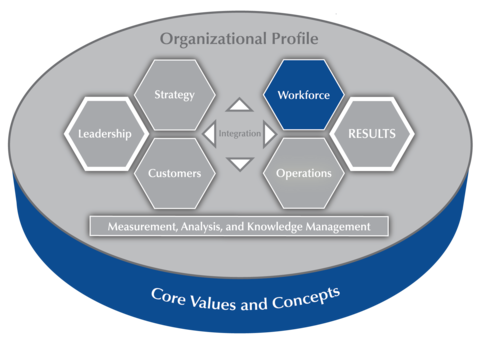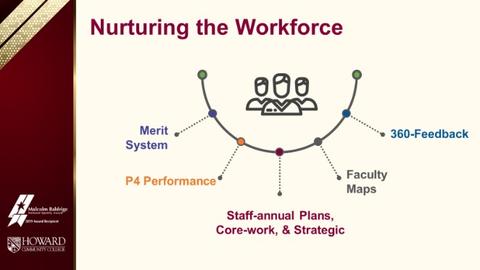Blogrige
The Official Baldrige Blog

Baldrige Criteria Blog Series
In this blog series, we are highlighting some of the learning (successful strategies and programs) shared by Baldrige Award recipients to highlight the categories of the Baldrige Criteria and how your organization might consider using them as inspiration.
Part of the purpose of the Malcolm Baldrige National Quality Improvement Act of 1987 (Public Law 100-107) is to disseminate information about the successful strategies and programs of Baldrige Award-winning organizations that “practice effective quality management and as a result make significant improvements in the quality of their goods and services.” Such sharing by Baldrige Award recipients is done at the Quest for Excellence® Conference, as well as at the Baldrige Fall Conference. Baldrige Award recipients also often host sharing days after their wins to share best practices.
What is Category 5?
Category 5 of the Baldrige Criteria covers your organization’s workforce.
Category 5: Workforce
This category addresses key workforce practices—those directed toward creating and maintaining a high‐performance environment and toward engaging your workforce to enable it and your organization to adapt to change and succeed.
Category 5 asks about your workforce capability and capacity needs, how you meet those needs to accomplish your organization’s work, and how you ensure a supportive work climate. You are also asked about your systems for managing workforce performance and developing your workforce members to enable and encourage all of them to contribute effectively and to the best of their ability.
Baldrige Award Recipient Best Practices
Following are some practices shared by Baldrige Award recipients (Adventist Health White Memorial, Howard Community College, and Illinois Municipal Retirement Fund) in the realms of workforce capability and capacity, support, engagement, performance development, and learning. What could your organization learn/adapt?
Adventist Health White Memorial
2019 Baldrige Award Recipient, Health Care
In alignment with its community-based vision, Adventist Health White Memorial (AHWM) ensures health, wholeness, and hope by focusing on people.
For example, in addition to programs to support community members (e.g., employing a former gang member to serve as a 24/7 gang liaison, raising more than $1 million through annual employee giving, and offering literal “showers of hope” for homeless community members), AHWM ensures that its clinical staff are supported and retained.
 Nurses
Nurses
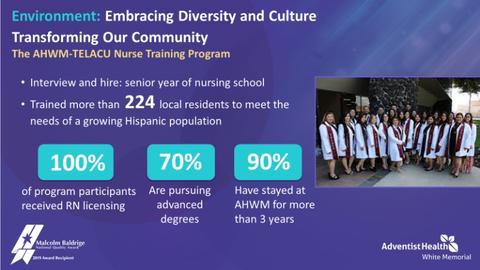
Over nearly two decades, AHWM has worked closely with its partners in the Hispanic-majority community to train local residents in nursing. AHWM’s Health Careers Pathway Partnerships with local high schools and colleges provide mentorship opportunities through hands-on activities, leadership development programs, and community service projects. Almost half the nursing scholarships awarded since 2018 went to residents in AHWM’s impoverished service area, resulting in a nursing staff that reflects the demographics (including culture and preferred language) of the community. Of more than 224 local trainees since the year AHWM won the Baldrige Award, 100% received registered nurse licensing, 70% pursued advanced degrees, and 90% stayed at AHWM for more than three years.
Physicians
Associate retention is part of a five-year core strategy called Business Transformation. To support ongoing retention, an Engagement Council monitors associate retention data (in measures of capability and capacity) and shares best practices among departments. In addition, a culture of empowerment promotes shared governance, an evidence-based practice that promotes joint accountability and responsibility for making decisions that affect work, including patient outcomes.
As a result of a focus on retention and culture, performance is at or very near the top quartile nationally for physician engagement factors, including for highly satisfied patients, according to a third-party physician engagement survey. In addition, AHWM’s medical resident retention rate has increased consistently at levels better than competing, regional hospitals since 2014, from 6% in 2014 to more than 40% in 2019.
Howard Community College
2019 Baldrige Award Recipient, Education
For 11 years in a row, Howard Community College (HCC) has been named a “Great College To Work For” (GCTWF) by the Chronicle of Higher Education based on employee ratings of collaborative governance, compensation and benefits, confidence in senior leadership, diversity, facilities, security, professional development, respect/appreciation, and work/life balance. This is not an easy feat, as HCC is one of only two community colleges in the nation to be recognized as a GCTWF in every year possible.
- Capability and capacity planning (e.g., through multi-year staffing plans, cross-functional teams, and robust surveys),
- Recruitment (e.g., through local, regional, and national searches),
Onboarding (e.g., through new employee info sessions, a buddy system, and a three-year development program for new faculty),
- Focusing on the drivers of engagement (e.g., through a merit system, 360-degree feedback, and faculty MAPs), and
- Refining and improving the drivers of engagement (e.g., through professional development, faculty mentoring, and professional learning communities).
In alignment with nurturing the workforce, processes are reviewed for continuous improvements and have resulted in the college adding behavioral interviewing training for supervisors, a new initiative to measure the engagement of minority employees, and a new employee web page. As a result, HCC’s overall turnover rate—defined as the number of full-time workforce employees who leave the college because of resignation, retirement, dismissal, or reorganization—was 6% better in the year it received the Baldrige Award than the Bureau of National Affairs annualized national rate.
In addition, the college’s effort to increase diversity in the employee applicant pool by targeting advertisements and announcements to minority-specific groups has resulted in a minority draw rate 3% higher than the minority population of the area it serves. In fall 2018, the percentage of minorities among full-time faculty was 28.4% and among administrative/professional staff was 31.9%--both the highest figures since records have been kept.
Illinois Municipal Retirement Fund
2019 Baldrige Award Recipient, Nonprofit
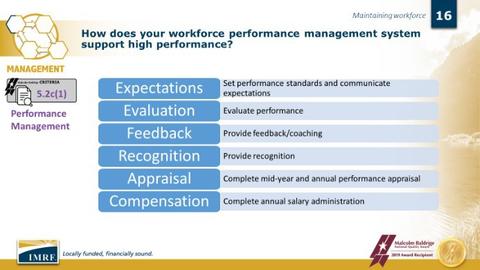
Performance management is just one of the 10 drivers of employee engagement for which the Illinois Municipal Retirement Fund (IMRF) equals or outperforms the top 25% on a national survey; other drivers for which IMRF excels are empowerment, culture, customer focus, rewards and recognition, co-worker relationships, department relationships, company potential, manager relationships, and senior manager relationships.
One of the ways that IMRF supports high performance is through its six-step Performance Management System, which also leverages compensation, reward, recognition, and incentive practices.
- Clarify expectations: Expectations for high-performance are communicated through job descriptions and performance standards. Standards are aligned with customer and business requirements such as accuracy and timeliness.
- Evaluate performance: Part of mid-year and annual reviews is goal accomplishment, which is aligned with action plans and set to achieve top-decile performance.
- Provide feedback: Feedback is aligned with the Leadership Scorecard and action plan performance measures. Voice-of-the-customer surveys provide another source of feedback to coach/train staff. As part of feedback and to reinforce intelligent risk taking, staff suggest improvements and participate in strength-weakness-opportunity-threat analyses.
- Recognize performance: Recognition is provided through “Kudos” awards, as well as town hall meetings, service anniversary celebrations, staff emails, and newsletters.
- Appraise performance: All staff receive a written performance appraisal that includes an evaluation of performance for the past year and goals for the next year. New hires receive a written appraisal at three months, mid-year, and annually. Appraisal forms are aligned with the key results areas of the Strategic Plan and Leadership Scorecard.
- Compensation: Since 2015, IMRF has been using a methodology to assess the compensation level of non-exempt staff based on years in role relative to the mid-point. This evaluation is completed annually to ensure appropriate placement within the salary range and helps to maintain internal equity.
Continue Learning Best Practices from Baldrige Award Recipients
- Attend the Baldrige Fall Conference, October 21-22, 2020, Milwaukee, WI
- Join us for the 32nd Quest for Excellence Conference, April 11-14, 2021, National Harbor, MD
- Explore Baldrige Award Recipient Application Summaries to learn how recipients addressed the Criteria questions
Baldrige Criteria Blog Series: Upcoming Blogs
Category 1: Leadership
Category 4: Measurement, Analysis, and Knowledge Managemen
Baldrige Criteria Blog Series: Previous Blogs
Category 2: Strategy
Category 3: Customers
Category 6: Operations
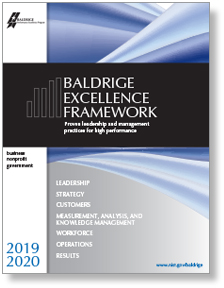
Baldrige Excellence Framework
The Baldrige Excellence Framework has empowered organizations to accomplish their missions, improve results, and become more competitive. It includes the Criteria for Performance Excellence, core values and concepts, and guidelines for evaluating your processes and results.
Purchase your copy today!
Available versions: Business/Nonprofit, Education, and Health Care


